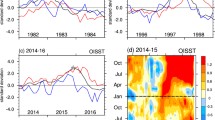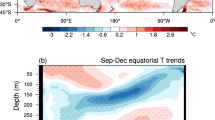Abstract
Anomalous warming occurred in the equatorial central-eastern Pacific in early May 2014, attracting much attention to the possible occurrence of an extreme El Niño event that year because of its similarity to the situation in early 1997. However, the subsequent variation in sea surface temperature anomalies (SSTAs) during summer 2014 in the tropical Pacific was evidently different to that in 1997, but somewhat similar to the situation of the 1990 aborted El Niño event. Based on NCEP (National Centers for Environmental Prediction) oceanic and atmospheric reanalysis data, the physical processes responsible for the strength of El Niño events are examined by comparing the dominant factors in 2014 in terms of the preceding instability of the coupled ocean–atmosphere system and westerly wind bursts (WWBs) with those in 1997 and 1990, separately. Although the unstable ocean–atmosphere system formed over the tropical Pacific in the preceding winter of 2014, the strength of the preceding instability was relatively weak. Weak oceanic eastward-propagating downwelling Kelvin waves were forced by the weak WWBs over the equatorial western Pacific in March 2014, as in February 1990. The consequent positive upper-oceanic heat content anomalies in the spring of 2014 induced only weak positive SSTAs in the central-eastern Pacific–unfavorable for the subsequent generation of summertime WWB sequences. Moreover, the equatorial western Pacific was not cooled, indicating the absence of positive Bjerknes feedback in early summer 2014. Therefore, the development of El Niño was suspended in summer 2014.
Similar content being viewed by others
References
Australian Government Bureau of Meteorology, 2014: El Niño remains on hold. [Available online at http://wdev.bom.gov.au/climate/enso/#tabs=Overview.]
Behringer, D., and Y. Xue, 2004: Evaluation of the global ocean data assimilation system at NCEP: The Pacific Ocean. Eighth Symposium on Integrated Observing and Assimilation Systems for Atmosphere, Oceans, and Land Surface, AMS 84th Annual Meeting, Washington State Convention and Trade Center, Seattle, Washington, 11–15.
Bergman, J. W., H. H. Hendon, and K. M. Weickmann, 2001: Intraseasonal air-sea interactions at the onset of El Niño. J. Climate, 14, 1702–1719.
Bjerknes, J., 1969: Atmospheric teleconnections from the equatorial pacific. Mon. Wea. Rev., 97, 163–172.
Chiodi, A. M., D. E. Harrison, and G. A. Vecchi, 2014: Subseasonal atmospheric variability and El Niño waveguide warming: Observed effects of the Madden-Julian Oscillation and westerly wind events. J. Climate, 27, 3619–3642.
Clement, A. C., R. Seager, M. A. Cane, and S. E. Zebiak, 1996: An ocean dynamical thermostat. J. Climate, 9, 2190–2196.
Cronin, M. F., and M. J. McPhaden, 1997: The upper ocean heat balance in the western equatorial Pacific warm pool during September–December 1992. J. Geophys. Res., 102, 8533–8553.
Fasullo, J., and P. J. Webster, 2000: Atmospheric and surface variations during westerly wind bursts in the tropical western Pacific. Quart. J. Roy. Meteor. Soc., 126, 899–924.
Fedorov, A. V., S. N. Hu, M. Lengaigne, and E. Guilyardi, 2015: The impact of westerly wind bursts and ocean initial state on the development, and diversity of El Niño events. Climate Dyn., 44, 1381–1401.
Gill, A. E., 1980: Some simple solutions for heat-induced tropical circulation. Quart. J. Roy. Meteor. Soc., 106, 447–462.
Hendon, H. H., and M. L. Salby, 1996: Planetary-scale circulations forced by intraseasonal variations of observed convection. J. Atmos. Sci., 53, 1751–1760.
Hendon, H. H., and J. Glick, 1997: Intraseasonal air-sea interaction in the tropical Indian and Pacific Oceans. J. Climate, 10, 647–661.
Jin, F.-F., 1997: An equatorial ocean recharge paradigm for ENSO. Part I: Conceptual model. J. Atmos. Sci., 54, 811–829.
Jones, C., D. E. Waliser, and C. Gautier, 1998: The influence of the Madden-Julian Oscillation on ocean surface heat fluxes and sea surface temperature. J. Climate, 11, 1057–1072.
Kalnay, E., and Coauthors, 1996: The NCEP/NCAR 40-year reanalysis project. Bull. Amer. Meteor. Soc., 77, 437–471.
Kiladis, G. N., G. A. Meehl, and K. M. Weickmann, 1994: Largescale circulation associated with westerly wind bursts and deep convection over the western equatorial Pacific. J. Geophys. Res., 99, 18 527–18 544.
Lai, A. W.-C., M. Herzog, and H.-F. Graf, 2015: Two key parameters for the El Niño continuum: Zonal wind anomalies and western Pacific subsurface potential temperature. Climate Dyn., doi: 10.1007/s00382-015-2550-0.
Lau, K. M., and P. H. Chan, 1986: The 40–50 day oscillation and the El Niño/Southern Oscillation: A new perspective. Bull. Amer. Meteor. Soc., 67, 533–534.
Lau, K.-M., and C.-H. Sui, 1997: Mechanisms of short-term sea surface temperature regulation: Observations during TOGA COARE. J. Climate, 10, 465–472.
Lengaigne, M., J.-P. Boulanger, C. Menkes, G. Madec, P. Delecluse, E. Guilyardi, and J. Slingo, 2003: The March 1997 westerly wind event and the onset of the 1997/98 El Niño: Understanding the role of the atmospheric response. J. Climate, 16, 3330–3343.
Madden, R. A., and P. R. Julian, 1971: Detection of a 40–50 Day Oscillation in the zonal wind in the tropical Pacific. J. Atmos. Sci., 28, 702–708.
Madden, R. A., and P. R. Julian, 1972: Description of global-scale circulation cells in the tropics with a 40–50 day period. J. Atmos. Sci., 29, 1109–1123.
Mao, J., and G. Wu, 2007: Interannual variability in the onset of the summer monsoon over the Eastern Bay of Bengal. Theor. Appl. Climatol., 89, 155–170.
Matsumo, T., 1966: Quasi-geostrophic motions in the equatorial area. J. Meteor. Soc. Japan., 44, 25–43.
McPhaden, M. J., 1999: Genesis and evolution of the 1997–98 El Niño. Science, 283, 950–954.
Menkes, C. E., M. Lengaigne, J. Vialard, M. Puy, P. Marchesiello, S. Cravatte, and G. Cambon, 2014: About the role of westerly wind events in the possible development of an El Niño in 2014. Geophys. Res. Lett., 41, 6476–6483.
National Aeronautics and Space Administration, 2014: Is El Niño developing? [Available online at http://earthobservatory.nasa. gov/IOTD/view.php?id=83653]
Philander, S. G. H., 1985: El Niño and La Niña. J. Atmos. Sci., 42, 2652–2662.
Reynolds, R. W., T. M. Smith, C. Y. Liu, D. B. Chelton, K. S. Casey, and M. G. Schlax, 2007: Daily high-resolutionblended analyses for sea surface temperature. J. Climate, 20, 5473–5496.
Sun, D.-Z., 2003: A possible effect of an increase in the warmpool SST on the magnitude of El Niño warming. J. Climate, 16, 185–205.
Sun, D.-Z., and Z. Y. Liu, 1996: Dynamic ocean-atmosphere coupling: A thermostat for the tropics. Science, 272, 1148–1150.
Sun, J. Z., T. Li, and R. H. Zhang, 2014: The initiation and developing mechanisms of central Pacific El Niños. J. Climate, 27, 4473–4485.
Sun, X. G., and X. Q. Yang, 2007: Numerical simulations of the interannual climate responses of East Asia to an El Niño event. Acta. Oceanologica Sinica, 29, 21–30.
Taylor, K. E., 2001: Summarizing multiple aspects of model performance in a single diagram. J. Geophys. Res., 106, 7183–7192.
Tollefson, J., 2014: El Niño tests forecasters. Nature, 508, 20–21.
Toyoda, T., S. Masuda, N. Sugiura, T. Mochizuki, H. Igarashi, M. Kamachi, Y. Ishikawa, and T. Awaji, 2009: A possible role for unstable coupled waves affected by resonance between Kelvin waves and seasonal warming in the development of the strong 1997–1998 El Niño. Deep-Sea Res., 56, 495–512.
Vecchi, G. A., and D. E. Harrison, 2000: Tropical Pacific sea surface temperature anomalies, El Niño, and equatorial westerly wind events. J. Climate, 13, 1814–1830.
Wang, B., R. G. Wu, and X. H. Fu, 2000: Pacific-East Asian teleconnection: How does ENSO affect East Asian climate? J. Climate, 13, 1517–1536.
Wang, H. J., 2000: The interannual variability of East Asian monsoon and its relationship with SST in a coupled Atmosphere-Ocean-Land climate model. Adv. Atmos. Sci., 17, 31–47.
Webster, P. J., V. O. Magaña, T. N. Palmer, J. Shukla, R. A. Tomas, M. Yanai, and T. Yasunari, 1998: Monsoons: Processes, predictability, and the prospects for prediction. J. Geophys. Res., 103, 14 451–14 510.
Wyrtki, K., 1975: El Niño-The dynamic response of the equatorial Pacific ocean atmospheric forcing. J. Phys. Oceanogr., 5, 572–584.
Wyrtki, K., 1985: Water displacements in the Pacific and the genesis of El Niño cycles. J. Geophys. Res., 90, 7129–7132.
Xie, S.-P., A. Kubokawa, and K. Hanawa, 1993: Evaporation-wind feedback and the organizing of tropaical convection on the planetary scale. Part I: Quasi-linear instability. J. Atmos. Sci., 50, 3873–3883.
Xue, Y., and Coauthors, 2012: A comparative analysis of upperocean heat content variability from an ensemble of operational ocean reanalyses. J. Climate, 25, 6905–6929.
Yang, S., 1996: ENSO-snow-monsoon associations and seasonalinterannual predictions. Int. J. Climatol., 16, 125–134.
Zastrow, M., 2014: Stalled El Niño poised to resurge. Nature, 513, 15.
Zhang, C. D., and J. Gottschalck, 2002: SST anomalies of ENSO and the Madden-Julian Oscillation in the equatorial Pacific. J. Climate, 15, 2429–2445.
Zheng, F., J. Zhu, H. Wang, and R.-H. Zhang, 2009: Ensemble hindcasts of ENSO events over the past 120 years using a large number of ensembles. Adv. Atmos. Sci., 26, 359–372, doi: 10.1007/s00376-009-0359-7.
Author information
Authors and Affiliations
Corresponding author
Rights and permissions
About this article
Cite this article
Li, J., Liu, B., Li, J. et al. A comparative study on the dominant factors responsible for the weaker-than-expected El Niño event in 2014. Adv. Atmos. Sci. 32, 1381–1390 (2015). https://doi.org/10.1007/s00376-015-4269-6
Received:
Revised:
Accepted:
Published:
Issue Date:
DOI: https://doi.org/10.1007/s00376-015-4269-6




